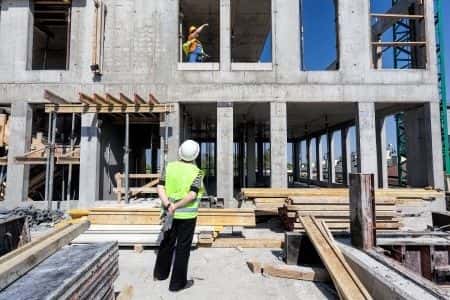A construction expert witness opines on a case involving falling concrete that injured a construction worker’s head. A steelworker was working for a subcontractor at the site of a restaurant addition when chips of cinder block struck his head. An employee of another subcontractor attempted to move a cinder block beam that had been lowered by a crane into place. His action caused the chunks of block to chip off and fall nearly 15 feet, striking the plaintiff below. The plaintiff was wearing a helmet. The chunk hit him in the head and shoulder, injuring his head, neck and shoulder. The plaintiff was treated at the hospital in New Hampshire. He missed work, suffered a loss of earnings, had medical expenses, endured pain, suffering, and disability and believes he will continue to suffer pain, loss of earning capacity, permanent disability and future medical expenses.
The plaintiff filed a negligence action against the subcontractor and general subcontractor at the site. The subcontractor was negligent for the way in which its employee attempted to guide or fit the brick beam into position, and was further negligent in failing to bar other workers on the job from entering an area of danger by sealing it off. The plaintiff alleges the general contractor violated state safety statutes by failing to seal off an area of potential danger for workers on the job site.
His two minor children filed a claim for loss of society and companionship resulting from the injuries sustained by their father. The plaintiff’s workers’ compensation insurer subrogated plaintiff’s action, filing a claim for a lien for medical expenses and disability benefits paid.
Question(s) For Expert Witness
What was the estimated force of the impact of the concrete on the plaintiff?
Expert Witness Response
The wall height was 13.75 feet and the plaintiff’s height was 5 feet, 8 inches. The chip size was 3 inches by 2 inches by 2 inches and 6 inches by 4 inches by one-half inch. From Giles Engineering sheet it was determined that a chip of this size would weigh 0.99 pounds.
Based on the photographs, the plaintiff was wearing a Type I, Class “E” and “G” helmet. Classes “E” and “G” are electrical classes and have no application in this particular case.
For the chip sizes mentioned, the chip would have had a downward velocity of 22.81 feet per second at the time it struck the side of the helmet. Assuming that the contact occurred over a time of 0.1 seconds with an impact angle of 15 degrees, the chip exerted a normal force on the helmet of 1.8 lbs. The harness would further reduce the force that was applied to the plaintiff’s head.
In conclusion, the falling chip would produce a force on his head of 1.8 pounds or less.
The expert is a professional engineer with a focus on biomedical and mechanical engineering and accident analysis and reconstruction.
About the author
Michael Morgenstern
Michael is Senior Vice President of Marketing at The Expert Institute. Michael oversees every aspect of The Expert Institute’s marketing strategy including SEO, PPC, marketing automation, email marketing, content development, analytics, and branding.



